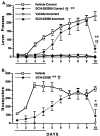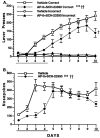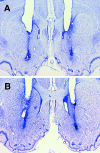Coincident activation of NMDA and dopamine D1 receptors within the nucleus accumbens core is required for appetitive instrumental learning
- PMID: 11027236
- PMCID: PMC6772875
- DOI: 10.1523/JNEUROSCI.20-20-07737.2000
Coincident activation of NMDA and dopamine D1 receptors within the nucleus accumbens core is required for appetitive instrumental learning
Abstract
The nucleus accumbens, a brain structure ideally situated to act as an interface between corticolimbic information-processing regions and motor output systems, is well known to subserve behaviors governed by natural reinforcers. In the accumbens core, glutamatergic input from its corticolimbic afferents and dopaminergic input from the ventral tegmental area converge onto common dendrites of the medium spiny neurons that populate the accumbens. We have previously found that blockade of NMDA receptors in the core with the antagonist 2-amino-5-phosphonopentanoic acid (AP-5; 5 nmol) abolishes acquisition but not performance of an appetitive instrumental learning task (Kelley et al., 1997). Because it is currently hypothesized that concurrent dopamine D(1) and glutamate receptor activation is required for long-term changes associated with plasticity, we wished to examine whether the dopamine system in the accumbens core modulates learning via NMDA receptors. Co-infusion of low doses of the D(1) receptor antagonist SCH-23390 (0.3 nmol) and AP-5 (0.5 nmol) into the accumbens core strongly impaired acquisition of instrumental learning (lever pressing for food), whereas when infused separately, these low doses had no effect. Infusion of the combined low doses had no effect on indices of feeding and motor activity, suggesting a specific effect on learning. We hypothesize that co-activation of NMDA and D(1) receptors in the nucleus accumbens core is a key process for acquisition of appetitive instrumental learning. Such an interaction is likely to promote intracellular events and gene regulation necessary for synaptic plasticity and is supported by a number of cellular models.
Figures




References
-
- Adriani W, Felici A, Sargolini F, Roullet P, Usiello A, Oliverio A, Mele A. N-Methyl-d-aspartate and dopamine receptor involvement in the modulation of locomotor activity and memory processes. Exp Brain Res. 1998;123:52–59. - PubMed
-
- Baldwin AE, Sadeghian K, Holahan MR, Kelley AE. cAMP-dependent protein kinase within the nucleus accumbens core mediate appetitive instrumental learning. Soc Neurosci Abstr. 1999;25:638. - PubMed
-
- Baldwin AE, Holahan MR, Sadeghian K, Kelley AE. N-Methyl-d-aspartate receptor-dependent plasticity within a distributed corticostriatal network mediates appetitive instrumental learning. Behav Neurosci. 2000;114:1–15. - PubMed
-
- Beninger RJ. The role of dopamine in locomotor activity and learning. Brain Res Rev. 1983;6:173–196. - PubMed
-
- Berridge KC, Robinson TE. What is the role of dopamine in reward: hedonic impact, reward learning, or incentive salience? Brain Res Rev. 1998;28:309–369. - PubMed
Publication types
MeSH terms
Substances
Grants and funding
LinkOut - more resources
Full Text Sources
Miscellaneous
